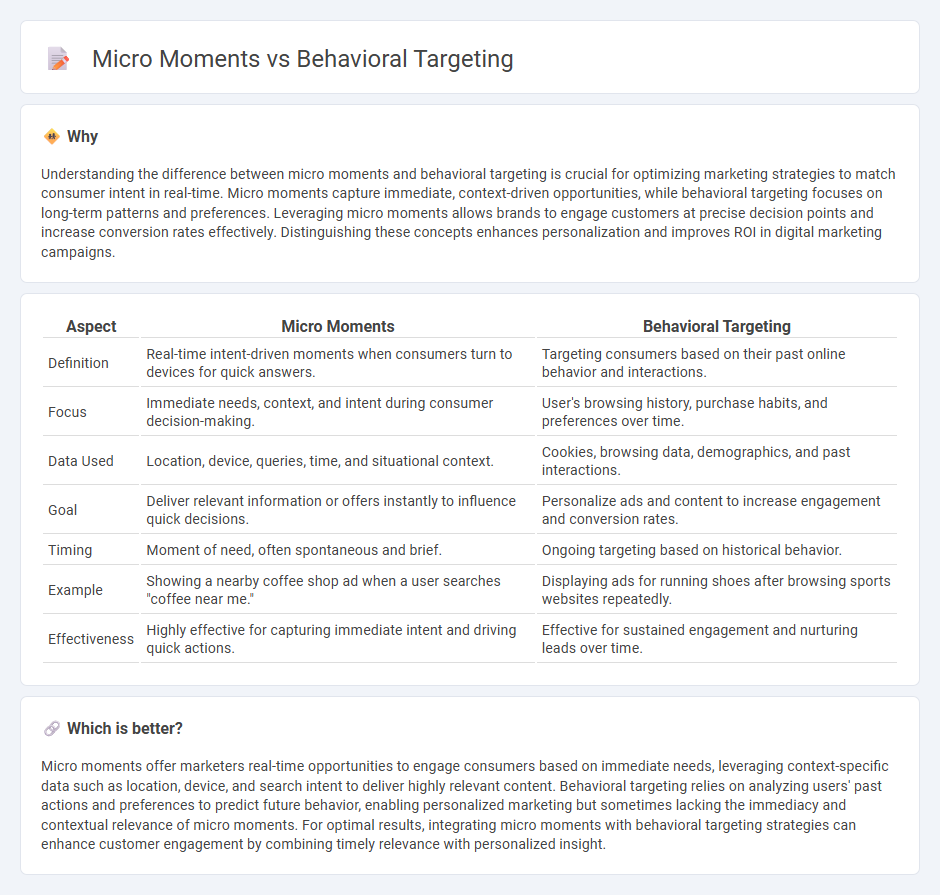
Micro moments capture real-time consumer intent by targeting specific instances when users turn to their devices for quick information, enabling marketers to deliver highly relevant content. Behavioral targeting relies on tracking past user actions and preferences to customize ads based on browsing history, purchase patterns, and demographic data. Explore how integrating micro moments with behavioral targeting can optimize your marketing strategy for higher engagement and conversion rates.
Why it is important
Understanding the difference between micro moments and behavioral targeting is crucial for optimizing marketing strategies to match consumer intent in real-time. Micro moments capture immediate, context-driven opportunities, while behavioral targeting focuses on long-term patterns and preferences. Leveraging micro moments allows brands to engage customers at precise decision points and increase conversion rates effectively. Distinguishing these concepts enhances personalization and improves ROI in digital marketing campaigns.
Comparison Table
| Aspect | Micro Moments | Behavioral Targeting |
|---|---|---|
| Definition | Real-time intent-driven moments when consumers turn to devices for quick answers. | Targeting consumers based on their past online behavior and interactions. |
| Focus | Immediate needs, context, and intent during consumer decision-making. | User's browsing history, purchase habits, and preferences over time. |
| Data Used | Location, device, queries, time, and situational context. | Cookies, browsing data, demographics, and past interactions. |
| Goal | Deliver relevant information or offers instantly to influence quick decisions. | Personalize ads and content to increase engagement and conversion rates. |
| Timing | Moment of need, often spontaneous and brief. | Ongoing targeting based on historical behavior. |
| Example | Showing a nearby coffee shop ad when a user searches "coffee near me." | Displaying ads for running shoes after browsing sports websites repeatedly. |
| Effectiveness | Highly effective for capturing immediate intent and driving quick actions. | Effective for sustained engagement and nurturing leads over time. |
Which is better?
Micro moments offer marketers real-time opportunities to engage consumers based on immediate needs, leveraging context-specific data such as location, device, and search intent to deliver highly relevant content. Behavioral targeting relies on analyzing users' past actions and preferences to predict future behavior, enabling personalized marketing but sometimes lacking the immediacy and contextual relevance of micro moments. For optimal results, integrating micro moments with behavioral targeting strategies can enhance customer engagement by combining timely relevance with personalized insight.
Connection
Micro moments--brief instances when consumers turn to their devices for quick decisions--are critical touchpoints that behavioral targeting leverages by analyzing user actions, preferences, and past interactions. This connection enables marketers to deliver highly personalized and contextually relevant ads in real time, optimizing engagement and conversion rates. Utilizing data from these micro moments enhances the precision of behavioral targeting strategies, driving improved customer experience and marketing ROI.
Key Terms
Data Segmentation
Behavioral targeting leverages data segmentation by analyzing user actions, preferences, and past interactions to create precise audience groups for tailored marketing campaigns. Micro-moments focus on real-time, context-driven data segmentation, capturing users' immediate intent to deliver highly relevant content at critical decision points. Explore how combining these data segmentation strategies enhances personalized marketing effectiveness.
Real-Time Interaction
Behavioral targeting leverages user browsing history, demographics, and past interactions to deliver personalized ads, enhancing marketing precision. Micro-moments focus on capturing consumer intent in real-time interactions, such as immediate desires or needs, by delivering relevant content at the exact moment users seek information. Explore how combining behavioral targeting with micro-moments maximizes engagement and conversion rates in dynamic digital environments.
Consumer Intent
Behavioral targeting analyzes consumers' past actions and online behavior to deliver personalized ads, while micro-moments capture real-time intent by addressing immediate, context-driven needs across devices. Understanding consumer intent through micro-moments allows brands to engage users precisely when they seek information, make decisions, or purchase, enhancing relevance and conversion rates. Explore how combining behavioral targeting with micro-moments can optimize marketing strategies for deeper consumer engagement.
Source and External Links
What Is Behavioral Targeting? How It Works (in 4 Steps) - Lotame - Behavioral targeting is a marketing method that collects and analyzes users' online behaviors to segment audiences and deliver precise, behavior-based ads, typically through data collection, segmentation, and targeted campaign execution.
A Guide to Behavioral Targeting and the Future of Digital Ads | Publift - Behavioral targeting identifies customers based on their online activity to serve ads to audiences most likely to convert, improving ad relevance regardless of the website's content.
What is Behavioral Targeting? | Examples, Benefits & How It Works - Behavioral targeting collects user activity data like browsing and purchase patterns, segments users by behavior (e.g., eco-conscious consumers), and targets ads accordingly to enhance relevance and engagement.
 dowidth.com
dowidth.com